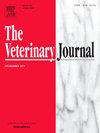Interference effect of foot-and-mouth disease maternal antibodies following foot-and-mouth disease vaccination and its related factors in Hanwoo beef calves
IF 3.1
2区 农林科学
Q1 VETERINARY SCIENCES
引用次数: 0
Abstract
Foot-and-mouth disease (FMD) vaccinations have been conducted in Korea for > 10 years. However, few studies have confirmed the optimal timing of FMD vaccination in newborn calves. In this study, we aimed to evaluate changes in antibodies before and after FMD vaccination and identify potential factors affecting FMD maternal-derived antibodies in newborn calves. Calves were vaccinated at 8 and 12 weeks of age. Blood samples were obtained from dams 6 weeks before the estimated due date and from calves at 8 (pre-vaccination), 12, and 16 weeks of age. Antibodies against the FMD virus (FMDV) structural proteins were detected using Priocheck FMDV type O antibody enzyme-linked immunosorbent assay. Among 82 calves, 54 (65.9 %) exhibited a decrease in FMD percentage inhibition (PI) at 16 weeks. The mean pre-vaccination FMD PI values of calves whose FMD PI decreased and increased after vaccination were 92.4 ± 9.4 and 72.4 ± 16.9, respectively (p < 0.05). Our results indicate that FMD vaccination at 8 weeks is early due to the high levels of maternal-derived FMD antibodies in the body of Hanwoo calves. The FMD PI of the dam (β = 0.636) exhibited the most significant impact on the FMD PI of 8-week-old calves, followed by calf birth weight (β = 0.200) (p < 0.05). Calves born to dams with high FMD PI and heavy birth weight exhibited high FMD PI at 8 weeks.
韩宇牛肉犊牛口蹄疫疫苗接种后口蹄疫母源抗体的干扰效应及其相关因素
在韩国进行口蹄疫(FMD)疫苗接种已经有10年了。然而,很少有研究证实在新生牛犊中接种口蹄疫疫苗的最佳时机。在本研究中,我们旨在评估接种口蹄疫疫苗前后的抗体变化,并确定影响新生小牛口蹄疫母源抗体的潜在因素。犊牛分别在8周龄和12周龄接种疫苗。在预估预产期前6周从母牛和8(接种前)、12和16周龄的小牛身上采集血液样本。采用Priocheck FMDV O型抗体酶联免疫吸附试验检测抗口蹄疫病毒(FMDV)结构蛋白抗体。在82头小牛中,54头(65.9 %)在16周时表现出口蹄疫抑制百分比(PI)的下降。接种后口蹄疫PI降低和升高的犊牛接种前口蹄疫PI均值分别为92.4 ± 9.4和72.4 ± 16.9 (p <; 0.05)。我们的研究结果表明,在8周时接种口蹄疫疫苗是早期的,因为韩宇小牛体内的母源口蹄疫抗体水平很高。坝体FMD PI对8周龄犊牛FMD PI的影响最显著(β = 0.636),其次是犊牛初生重(β = 0.200) (p <; 0.05)。高FMD PI和高出生体重的犊牛在8周时FMD PI较高。
本文章由计算机程序翻译,如有差异,请以英文原文为准。
求助全文
约1分钟内获得全文
求助全文
来源期刊

Veterinary journal
农林科学-兽医学
CiteScore
4.10
自引率
4.50%
发文量
79
审稿时长
40 days
期刊介绍:
The Veterinary Journal (established 1875) publishes worldwide contributions on all aspects of veterinary science and its related subjects. It provides regular book reviews and a short communications section. The journal regularly commissions topical reviews and commentaries on features of major importance. Research areas include infectious diseases, applied biochemistry, parasitology, endocrinology, microbiology, immunology, pathology, pharmacology, physiology, molecular biology, immunogenetics, surgery, ophthalmology, dermatology and oncology.
 求助内容:
求助内容: 应助结果提醒方式:
应助结果提醒方式:


